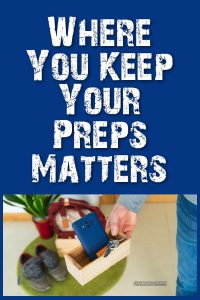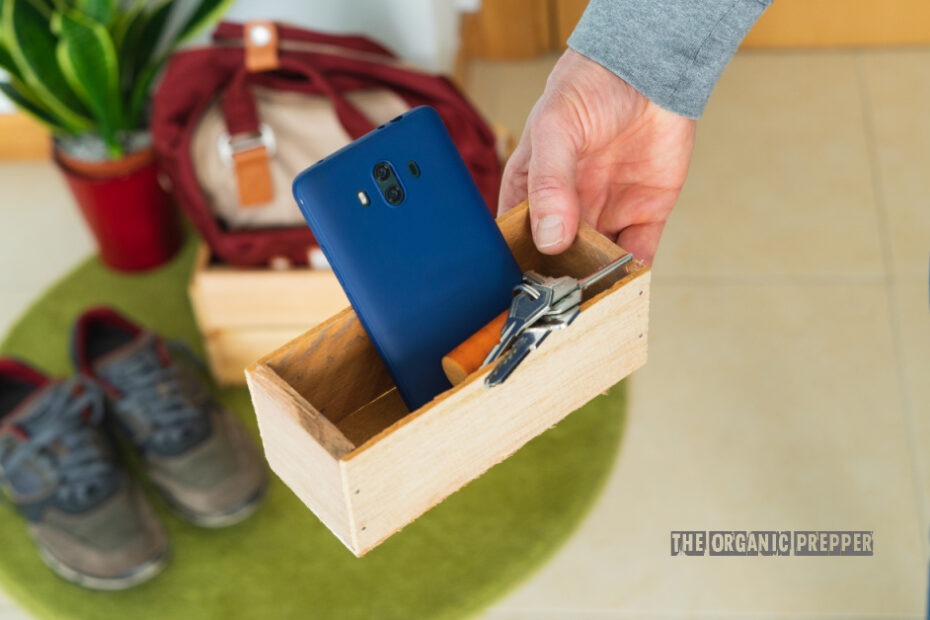[ad_1]
(Psst: The FTC wants me to remind you that this website contains affiliate links. That means if you make a purchase from a link you click on, I might receive a small commission. This does not increase the price you’ll pay for that item nor does it decrease the awesomeness of the item. ~ Daisy)
Author of How to Prep When You’re Broke and Bloom Where You’re Planted online course
One thing I learned when I went to Croatia to take Selco’s Urban Survival Course for Women years ago was that how you pack your bag matters. (He wrote about it here.) Taking that a step further, it also matters where you keep your preps in your home.
When Selco explains how to carry your gear, he talks about layers. Your first layer, he says, should be on your body so that you have immediate access to it no matter what. You can lose a bag, you can be away from your car or cache, but the stuff on your body is immediately at hand. This might include carrying a knife around your neck, some urgent first aid supplies in your cargo pants pocket (such as a compression bandage), a lighter in another pocket, a portable water filter in a waist bag, and a firearm in a holster at your waist. For ladies, you might have some of these items in a cross-body style purse. Then you have things you might urgently need to survive close at hand.
I believe the same thing holds true for supplies in my house. Here are a few suggestions about where you might keep your preps at home.
Layers count at home, too.
What are the things you might need most urgently when you’re at home? I’m talking fast access, not climbing up to the attic or digging through an overstuffed closet. This first layer for the home is similar to the first layer on the body that Selco described.
Where you keep your preps could mean the difference between seconds and minutes in an emergency. I want access immediately to the following items:
- Flashlights
- Urgent trauma care first aid supplies like pressure bandages, tourniquets, and EpiPens
- Packed bug-out bag
- Important documents
- Weapons
Nearly anything else can wait until I dig it out, but these things could be needed urgently. So, where can you keep your preps so they’re easily accessible but not blatantly screaming that you’re stocked to the rafters?
Prioritize these places for the first layer.
There are a few home hotspots where I like to keep supplies, and I have duplicates of some items for this reason.
By My Bed
First of all, I like to have the things I might need when waking up in the middle of the night close at hand. By my bed, I keep these essentials:
- Shoes or slippers with a hard sole – these will protect my bare feet if there is some kind of middle-of-the-night emergency that causes broken glass or debris
- Flashlight – I keep one right on my nightstand so that I can see what’s going on if the power is out.
- Firearm – This is also on my nightstand when I sleep for the obvious reasons.
- Folding knife – I keep a small one tucked into my pillow case, clipped onto the hem. It’s a backup in case there’s some reason I can’t get to my gun.
- Phone and charger – If I need to call for help my phone is on my nightstand, which has a charging port built in.
Now, I don’t have small children at home. If I did, I’d probably change where I kept my gun at night to some place they couldn’t access it if they popped in for a midnight snuggle.
By the chair in the living room
This area is really similar to my bed. If I’m sitting there, I’m relaxed. My end table has a little drawer that holds a firearm and a small flashlight. During the day, a pocket knife lives in my pocket, so that is always on me.
By the door
If you had to get the heck out of your house in a split second, how long would it take you to gather the most important things? I keep those things right by the door so that I can dash out of here fast in an emergency, and I’ve done so ever since I lived in wildfire country back in California.
- Bug-out bag – I keep one packed and in the entryway closet, on the shelf. It’s easy to get to and always ready to go.
- Important documents – I keep photocopies of these in my bug-out bag, a set in the cloud, and a folder with originals in the drawer of the table by the door. They’re in a fireproof document folder for an added layer of protection.
- Keys – If I’m at home, my keys are always on a hook by the door. ALWAYS.
- Sturdy shoes – We don’t wear outdoor shoes in the house in my family. I always have a pair of sturdy hiking shoes by the door for emergencies. Extra socks are in my bug-out bag, so if I have to jam bare feet into the boots, it’s only temporary.
- Flashlight – I always keep a flashlight right beside the door in case I need to go outside and see what’s going on. I started this habit when we lived in the Algonquin Forest – it was so incredibly dark there, far from civilization. The flashlight I keep by the door is the spotlight type. It’s also handy if the dog needs to go outside.
With these things by the door, I can leave fast if the situation calls for it. And it’s not just for natural disasters. These things are helpful for other types of emergencies, too. When I had to rush to the hospital for a family member one night, I grabbed my purse and my bug-out bag and had everything I needed to stay there overnight.
In the kitchen
Did you know that most accidents at home happen in the kitchen? Statistically speaking, “Two-thirds of home fires start in the kitchen, 480 people die a year in kitchen fires, and 350,000 people are injured by kitchen knives each year. The most common injuries are burns, fires, and lacerations.”
I base my kitchen preps on these threats.
- Fire extinguisher – I always, always have a fire extinguisher in the kitchen. (At least one.) These aren’t extremely expensive and it could save both your home and your life. I like this brand of fire extinguisher for its reasonable price and reliability. I keep one mounted in the cabinet beside the stove for fast access and a second one across the kitchen in case I can’t get to the first one due to the fire. When my daughter was 13, she had an unfortunate macaroni and cheese accident and used the fire extinguisher herself to deal with it. I believe these are vital additions to your home.
- Fire blankets – Another really useful addition to the kitchen that is in the cabinet beside the stove is a fire blanket. Some fires need to be smothered – and if someone catches a sleeve on fire or something, these could be urgently needed.
- First aid supplies – I keep a small stash of supplies to stop bleeding in my kitchen – you know, where all the sharp knives live. Under my sink I have a little kit containing a packaged compression bandage, a tourniquet that can be applied with one hand, and then some everyday bandaids for little cuts. If I were to sustain a bad cut, my immediate need is to stop the bleeding. I don’t need my aftercare items like wash, ointments, and gauze to be in the kitchen because I’m probably not going to clean and dress the wound there.
The philosophy of where you keep your preps
Things that are life and death matters – something you need urgently and immediately – should be stored where you are the most  likely to need it. If you have a tractor, for example, you might want to keep a trauma kit in it. If you work on your car in your garage, you might require the same type of prep. If you have a workshop with a butane torch, you may want fire prevention items nearby.
likely to need it. If you have a tractor, for example, you might want to keep a trauma kit in it. If you work on your car in your garage, you might require the same type of prep. If you have a workshop with a butane torch, you may want fire prevention items nearby.
You get the idea.
Having things close at hand can save you valuable seconds in a life-or-property-threatening scenario. It will only take a few minutes of your time to move everything into place, but when you need those items, you’ll be exceptionally glad you took the time to locate them conveniently.
So often, prepping isn’t about the huge expenses like a generator or a fancy new rifle. It’s about the little things, like having the things you need when and where you need them. Relocating a few supplies is something anyone, at any level, can do to be better prepared.
Where you keep your preps matters.
Do you have any little survival stations around your home and property? What kinds of things do you stash there? Where do you think it’s important to have a small stash of emergency supplies?
Let’s talk more about where to keep your preps in the comments section.
About Daisy
Daisy Luther is a coffee-swigging, adventure-seeking, globe-trotting blogger. She is the founder and publisher of three websites. 1) The Organic Prepper, which is about current events, preparedness, self-reliance, and the pursuit of liberty; 2) The Frugalite, a website with thrifty tips and solutions to help people get a handle on their personal finances without feeling deprived; and 3) PreppersDailyNews.com, an aggregate site where you can find links to all the most important news for those who wish to be prepared. Her work is widely republished across alternative media and she has appeared in many interviews.
Daisy is the best-selling author of 5 traditionally published books, 12 self-published books, and runs a small digital publishing company with PDF guides, printables, and courses at SelfRelianceand Survival.com You can find her on Facebook, Pinterest, Gab, MeWe, Parler, Instagram, and Twitter.
[ad_2]
Source link
